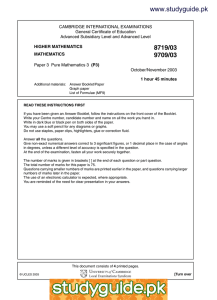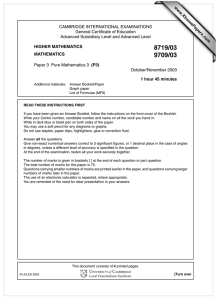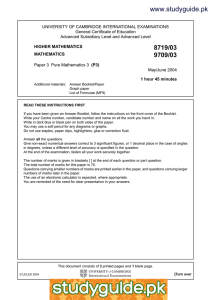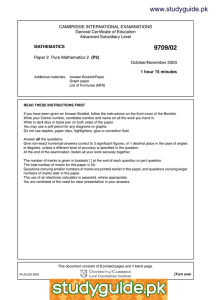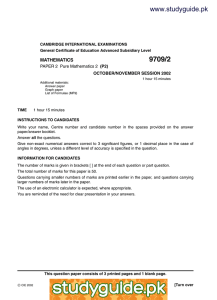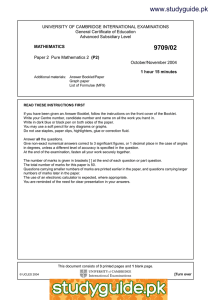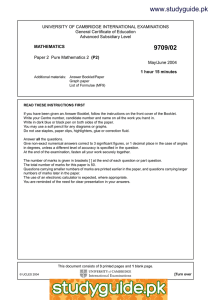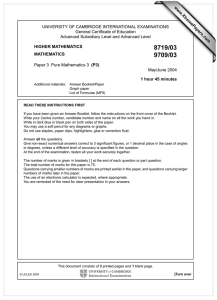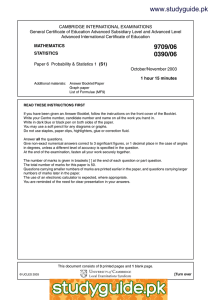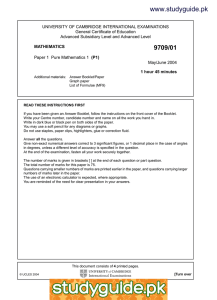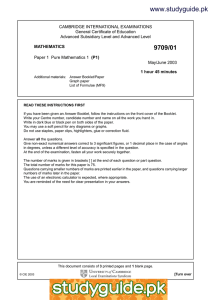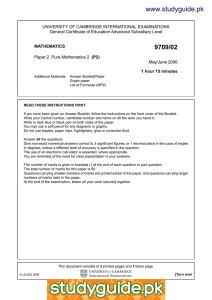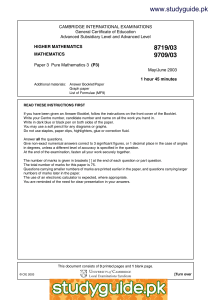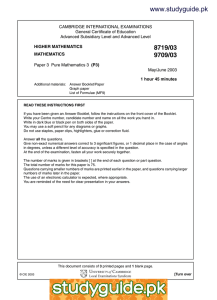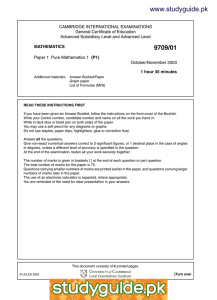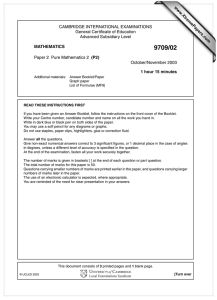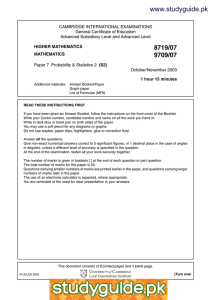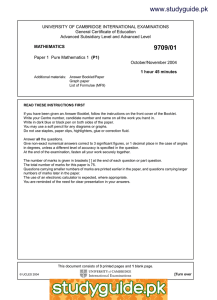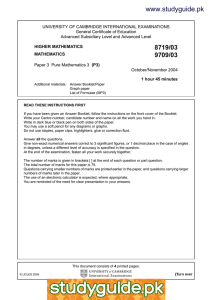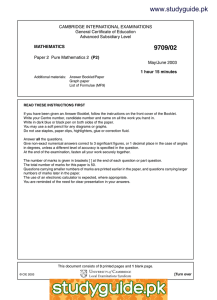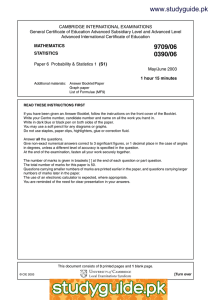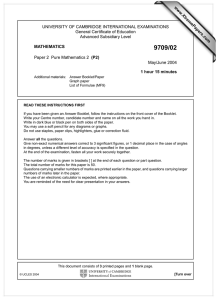www.studyguide.pk
advertisement
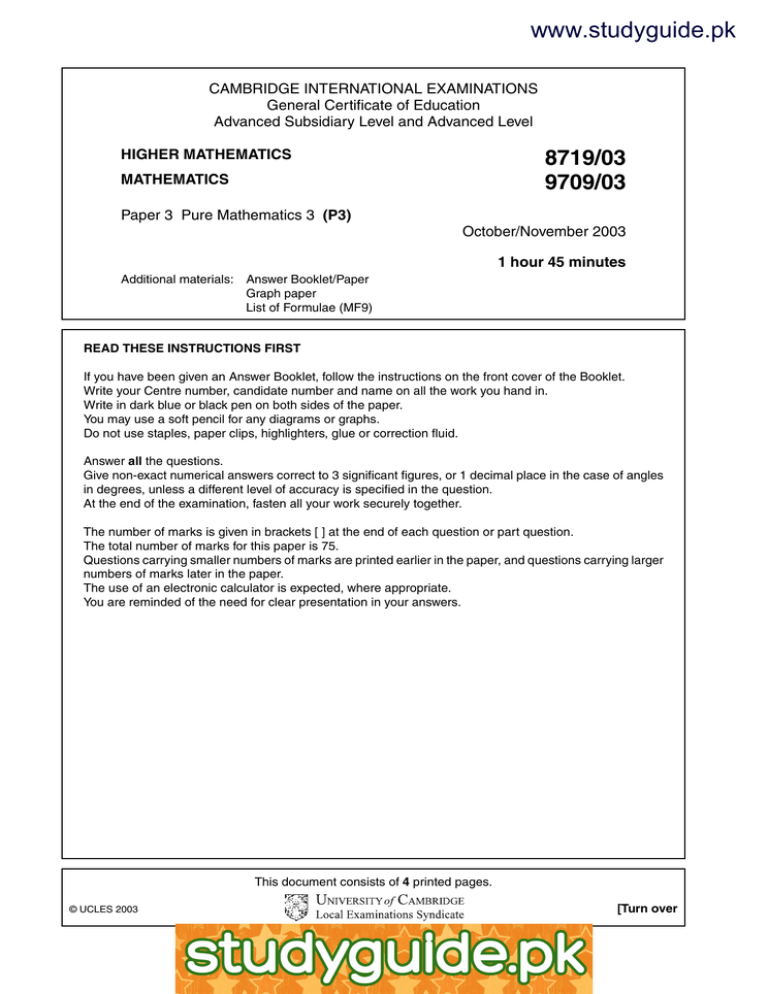
www.studyguide.pk CAMBRIDGE INTERNATIONAL EXAMINATIONS General Certificate of Education Advanced Subsidiary Level and Advanced Level HIGHER MATHEMATICS 8719/03 9709/03 MATHEMATICS Paper 3 Pure Mathematics 3 (P3) October/November 2003 1 hour 45 minutes Additional materials: Answer Booklet/Paper Graph paper List of Formulae (MF9) READ THESE INSTRUCTIONS FIRST If you have been given an Answer Booklet, follow the instructions on the front cover of the Booklet. Write your Centre number, candidate number and name on all the work you hand in. Write in dark blue or black pen on both sides of the paper. You may use a soft pencil for any diagrams or graphs. Do not use staples, paper clips, highlighters, glue or correction fluid. Answer all the questions. Give non-exact numerical answers correct to 3 significant figures, or 1 decimal place in the case of angles in degrees, unless a different level of accuracy is specified in the question. At the end of the examination, fasten all your work securely together. The number of marks is given in brackets [ ] at the end of each question or part question. The total number of marks for this paper is 75. Questions carrying smaller numbers of marks are printed earlier in the paper, and questions carrying larger numbers of marks later in the paper. The use of an electronic calculator is expected, where appropriate. You are reminded of the need for clear presentation in your answers. This document consists of 4 printed pages. [Turn over © UCLES 2003 www.xtremepapers.net www.studyguide.pk 2 1 Solve the inequality 2x − 8 < 5. 2 Expand (2 + x2 )−2 in ascending powers of x, up to and including the term in x4 , simplifying the coefficients. [4] 3 Solve the equation [4] cos θ + 3 cos 2θ = 2, giving all solutions in the interval 0◦ ≤ θ ≤ 180◦ . 4 The equation of a curve is √ [5] √ √ x + y = a, where a is a positive constant. (i) Express dy in terms of x and y. dx [3] (ii) The straight line with equation y = x intersects the curve at the point P. Find the equation of the [3] tangent to the curve at P. 5 (i) By sketching suitable graphs, show that the equation sec x = 3 − x2 has exactly one root in the interval 0 < x < 12 π . [2] (ii) Show that, if a sequence of values given by the iterative formula xn+1 = cos−1 1 3 − x2n converges, then it converges to a root of the equation given in part (i). [2] (iii) Use this iterative formula, with initial value x1 = 1, to determine the root in the interval 0 < x < 12 π correct to 2 decimal places, showing the result of each iteration. [3] 9709/03/O/N/03 www.xtremepapers.net www.studyguide.pk 3 6 y B x A O M The diagram shows the curve y = (3 − x)e−2x and its minimum point M . The curve intersects the x-axis at A and the y-axis at B. (i) Calculate the x-coordinate of M . [4] (ii) Find the area of the region bounded by OA, OB and the curve, giving your answer in terms of e. [5] 7 The complex number u is given by u = 7 + 4i . 3 − 2i (i) Express u in the form x + iy, where x and y are real. [3] (ii) Sketch an Argand diagram showing the point representing the complex number u. Show on the same diagram the locus of the complex number such that − u = 2. [3] (iii) Find the greatest value of arg for points on this locus. 8 Let f(x) = [3] x3 − x − 2 . (x − 1)(x2 + 1) (i) Express f(x) in the form A+ B Cx + D , + 2 x−1 x +1 where A, B, C and D are constants. [5] 3 (ii) Hence show that f(x) dx = 1. [4] 2 9709/03/O/N/03 www.xtremepapers.net [Turn over www.studyguide.pk 4 9 Compressed air is escaping from a container. The pressure of the air in the container at time t is P, and the constant atmospheric pressure of the air outside the container is A. The rate of decrease of P is proportional to the square root of the pressure difference (P − A). Thus the differential equation connecting P and t is √ dP = −k (P − A), dt where k is a positive constant. (i) Find, in any form, the general solution of this differential equation. (ii) Given that P = 5A when t = 0, and that P = 2A when t = 2, show that k = 10 [3] √ A. [4] (iii) Find the value of t when P = A. [2] (iv) Obtain an expression for P in terms of A and t. [2] The lines l and m have vector equations r = i − 2k + s(2i + j + 3k) and r = 6i − 5j + 4k + t ( i − 2j + k ) respectively. (i) Show that l and m intersect, and find the position vector of their point of intersection. [5] (ii) Find the equation of the plane containing l and m, giving your answer in the form ax + by + c = d. [6] 9709/03/O/N/03 www.xtremepapers.net
